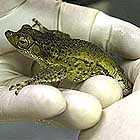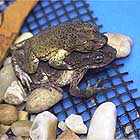|
 |
|
Esta página no está disponible en español. The Washington PostFor Rare Toad To Survive, Breeding Is FundamentalReptile Keeper Wants To See Little TadpolesBy Tammie Wersinger
July 21, 2002
In caring hands. (DENNIS WALL/ORLANDO SENTINEL) ---------- Iris Pitre can remember the distinctive call of the coqui in Puerto Rico, but the croaking of the island's crested toad escapes her memory. "Never heard of 'em. Maybe you mean the coqui," said Pitre of Deltona. The little pointy-nosed, bulging-eyed, brownish-tan crested toad was on the verge of extinction but has made a comeback, thanks to places such as the Central Florida Zoo and a captive-breeding program. Unlike its popular cousin whose "coh-key" cry is heard all over Puerto Rico, the crested toad's wild population now emanates from a single breeding pond in the Guanica Commonwealth Forest. Because of its rarity, the crested toad was the first amphibian to be considered for the American Zoo and Aquarium Species Survival Plan, or SSP. That's where the Central Florida Zoo fits in. It is the job of reptile keeper Bradley Lawrence and his co-workers to get the nine toads under their care to produce offspring. At the Sanford park, Lawrence provides a little background music -- a recording of the toads' mating call -- and a natural environment. Although most Puerto Rican crested toads don't breed until late summer, there seems to be a lot of practicing going on, Lawrence said. No little tadpoles have come from the young couple, but Lawrence is hopeful his zoo will play a valuable role in multiplying the toad's population. In addition to building a cheap home in a 50-gallon plastic drum, Lawrence hopes his work eventually will lead to tadpoles being born here and sent back to Puerto Rico.
There's hope. (DENNIS WALL/ORLANDO SENTINEL) ---------- "This is pretty much one of the rarest amphibians in the world," Lawrence said. When the crested toad became part of the species survival plan 15 years ago, about 200 were thought to live on Puerto Rico's southwest coast. There was a smaller population on the north coast of the island, but it is now "functionally extinct,"' said Fred Antonio, general curator at the Central Florida Zoo. From the six that were collected from the wild in 1982, thousands of tadpoles have been hatched. Twenty American Zoo and Aquarium institutions participate in the Puerto Rican Crested Toad Recovery program, which is coordinated by the Toronto Zoo. In 2000, 26,000 tadpoles were released into the wild. If 10 percent of those survive into adulthood, it will be considered a success, Antonio said. Antonio was able to see firsthand the extreme environment that the toads live in when he traveled to Puerto Rico recently. He visited the last wild breeding pond in a parking lot at the end of a two-lane road. "If it weren't for the sign at the front of the parking lot, I never would have guessed that this was the home of these rare toads," Antonio said.
|

 ----------
---------- ----------
----------